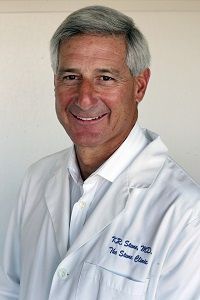Article
Orthopedic Surgeon Doesn't Simply Heal, He Improves
Author(s):
An orthopedic surgeon pushes the limits of what's possible as he practices on the cutting edge of knee repair. Meanwhile, he pushes his patients to raise their own expectations of what they're capable of.

When Kevin Stone, MD, was a soccer player at Harvard he injured his knee and had his meniscus cartilage removed. While hampering Stone’s athletic abilities, it also gave rise to a very rewarding and innovative career in orthopedic surgery.
“I admired the orthopedic surgeon who fixed [my knee], and thought that I might be able to enjoy a career like that,” Stone recalls.
However, Stone had not yet determined the focus of his medical aspirations. He began in internal medicine at Harvard, switched to general surgery at Stanford, then settled in at orthopedic surgery back at Harvard.
“I wanted to focus my time and efforts in research on solving the problems of loss of the meniscus cartilage as I had lost mine.”
And he’s been leading the charge in that field ever since.
Three-Pronged Focus
Stone’s father and grandfather were both solo practitioners, so his affinity for the medical field was well-formed through family history. But the ambitious path he has taken since 1988 when he started The Stone Clinic has led him to become not only one of the leading sports injury physicians in the country, but also a pioneer in stem cell knee repair.
Following his fellowship in research at the Hospital for Special Surgery, and in knee surgery in Lake Tahoe, Stone established his solo practice where he divided his career between clinical practice, nonprofit research, and for-profit research.
“My clinical and research focus is on biologic joint repair and regeneration for the knee, shoulder, and ankle to keep injured people and people with arthritis active,” Stone says.
Along the way he has served as a physician for the US Ski Team, the US Pro Ski Team, the Honda Ski Tour, the Jeep 48 Straight Tour, the Old Blues Rugby Club, Lawrence Pech Dance Company, Marin Ballet, the modern pentathlon at the US Olympic Festival, and the US Olympic Training Center. He is presently a physician for Smuin Ballet.
But Stone also recognizes that everyone is an athlete in one way or another.
“Even if your sport is just going to the store or walking in the mall, everyone wants to be able to do that without pain,” he explains. “And so it’s finding the athlete inside of each person, and setting goals for them or helping them achieve their goals that they otherwise would never have done before.”
The Stone Clinic Method
What makes The Stone Clinic different from other orthopedic clinics is the biologic approach it takes to treating joint injuries and arthritis. The clinic focuses on regenerating and rebuilding rather than replacing with metals and plastics, preserving as much of the natural biology of the joint as possible.
Stone started by re-growing the meniscus cartilage into a collagen scaffold that he designed, which encouraged the body’s own bones to grow into it, thus leading to the first regeneration template from tissue engineering in orthopedics.
From there, Stone moved on to articular cartilage, and developed a technique for re-growth called “articular cartilage paste grafting,” which uses the patient’s own cartilage, bone and stem cells to re-grow damaged articular cartilage in the knees of patients with arthritis or isolated sports injuries. He built on that by developing a technique for replacing the entire articular cartilage with allograft tissue—or donor tissue—and then expanded the work to design a new method of replacing the anterior cruciate ligament using pig tissue.
“This combination of being able to restore the articular cartilage, the ligaments, and the meniscus in people’s knees has become our focus of what we call a bio-knee program,” Stone says. “And bio-knee means biologically replacing the missing surfaces rather than artificially replacing it.”
Better than Before
The clinic also works with patients to help them improve their lives from a non-operative, fitness and training approach. The focus, Stone says, is to help patients see themselves as athletes in training rather than patients in rehab. In effect, partnering with patients; establishing a contract between them and the clinic.
“The contract,” Stone says, “is that I give them my best effort and they have to give me their best effort in the rehabilitation program. It’s the rehabilitation program that helps define the success, enabling them to regain a level of fitness better than they were before they were injured.”
Stone understands the athlete inside his patients. He’s an avid skier, windsurfer and biker who believes that sports help to clear the mind; help with thinking outside the box, and getting back in touch with your own body.
“Whether you push for training or push for relaxation and clearing your thoughts, exercising every day, seven days a week, is a very important part of a healthy lifestyle.”
Constant Improvement
Stone is also an inventor who holds more than 40 US patents on novel inventions to improve healthcare and procedures for patients. He believes that anything can be done better. And if he’s performing a procedure this year the exact same way he did the previous one, then he hasn’t learned anything.
“It’s the desire to make things better, and to look at everything we’re doing and try to figure out how to do them better that naturally leads to inventing new ways of doing things,” Stone says. “Helping patients achieve their goals is always most rewarding. It’s the inspiration for what we do.”
Patient feedback is important, too—just not as important as the actual outcomes.
“In medicine, we’re privileged to have that kind of feedback, but it’s not the most important thing,” Stone says. “Helping people to not just achieve their goals, but also set new ones and become more fit and faster than they’ve been in years is probably the most satisfying thing we do.”




